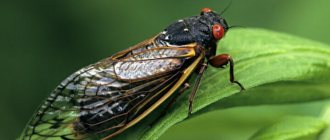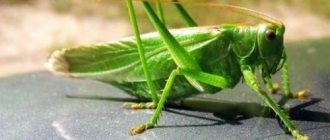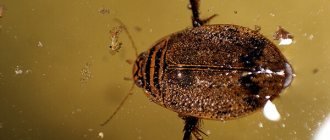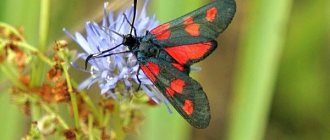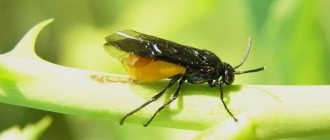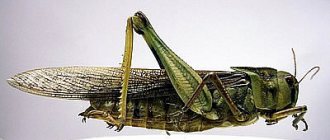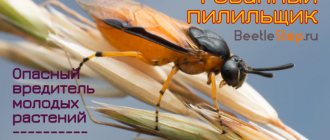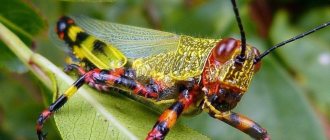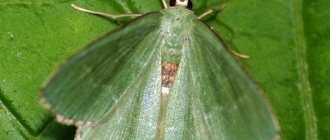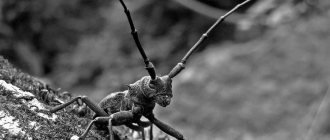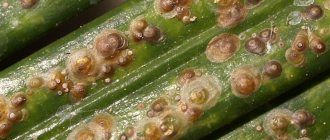- Wild animals
- >>
- Insects
Locusts are one of the most dangerous insects for the national economy. The pest of agricultural and wild crops is widespread throughout the planet. Once upon a time, in ancient times, locust raids not only destroyed crops, but could lead to starvation of an entire people. A single individual is completely harmless, but when it joins the ranks of a flock, it easily destroys all crops in its path.
Origin of the species and description
Photo: Locust
The locust is a gregarious insect of the true locust family. This large arthropod insect, part of the ranks of Orthoptera of the suborder Short-whiskered, reaches quite large sizes in growth from 1 cm to 6 cm. Some individuals in rare cases reach 14 cm in length. Females are much larger than males. The locust looks very much like a grasshopper. The color of locusts performs a camouflage function and can change depending on environmental factors.
Video: Locust
The word "locust" translated from Turkic means "yellow". The locust is an unpretentious and harmful insect that can be found in all corners of the planet, except permafrost. The harsh climate is not suitable for insect life. Locusts love warmth and sunlight. The average lifespan of a locust ranges from eight months to two years, and the insect can be in different life phases: the solitary phase and the gregarious phase.
The phases differ significantly from each other and affect not only the color of the insect, but also its behavior. There are a large number of locust species, up to ten thousand; the most dangerous are the Asian and migratory ones. Locusts are vegetarians and eat any green plants.
Interesting fact: As a result of friction against each other, the wings of locusts make a sound similar to creaking in flight. When a huge flock of insects flies, a sound is formed that resembles a strong hum, which can be heard over long distances. Some people mistake this sound for thunder.
Phases of development
As has already been noted, locusts have two development options: solitary and gregarious, which are strikingly different from each other.
Single cycle
The locust filly, as single individuals are called, develops freely with an abundance of food and leads an inactive, shy lifestyle, which is why it was previously systematized as a separate species. Single individuals are characterized by camouflage coloration and pronounced sexual dimorphism. The filly does not cause significant harm.
In fact, a single phase of locust development is necessary for the preservation of the population. The female lays eggs and when the food supply becomes insufficient to feed all the larvae, the locust moves on to another stage of development.
Herd development
Association in swarms is observed in hot, dry years, when locusts begin to experience a shortage of food and moisture. According to recent studies, a lack of protein provokes females to intensively lay so-called “campaign” offspring.
Interesting! In laboratory conditions, many mirrors were placed in the area of a sedentary filly. Seeing her reflections, the female began to actively lay eggs according to the “walking program”.
Gathering into a large tribe, intense friction against each other, the visibility of their own kind, the smell of fellow tribesmen causes a powerful production of serotonin in the nervous system.
Due to the release of the hormone, individuals literally undergo dramatic morphological changes in a matter of hours:
- change of color;
- increase in size;
- leveling sexual dimorphism.
Clusters of adult flying locusts are called swarms; the larvae form swarms. The population moves, as if on command, in one direction. Weakened individuals are eaten along the way by their fellow tribesmen. Adult locusts are capable of long flights and cover from 90 to 140 km per day.
The length of the flocks is measured in tens of kilometers, and the number can reach several billion individuals. The weight of such “collectives” reaches tens of tons.
The locust invasion cannot go unnoticed. The sound of approaching insects is comparable to the sound of thunder, and the flock itself covers the sun.
On its way, the flock devours literally everything, even the thatched roofs of houses, vineyards, orchards, vegetable and grain plantations. Just decades ago, locust attacks caused famine. Now the flocks are causing colossal losses to farmers. In 2015, a locust invasion in Russia destroyed an area comparable to the territory of an entire state, for example, Romania.
Appearance and features
Photo: What locusts look like
By nature, the locust has an elongated body and six legs, two of which, namely the front ones, are weak. One back is longer than the other and many times stronger. In nature, there are individuals whose body length reaches fifteen centimeters. Typically, the body length ranges from 3 to 7 cm. The locust also has a large head with pronounced eyes.
The wings are transparent and practically invisible when folded and are covered with two solid elytra. Locusts are one of the oldest representatives of the Orthoptera order. There are about twenty thousand species around the world. The color of the locust depends only on the place where it lives and where it was formed. Therefore, specimens that appeared at the same time from the same female can be completely different colors, provided that they are raised in different conditions.
The appearance of locusts largely depends on the stage of their formation. The color of singles is a camouflage suit of green-yellow or walnut color. The shade depends entirely on the region of residence of such an insect. When a flock is formed, all its members become similar to each other. There are no differences between individuals, including no division by gender. Locusts can cover a distance of 200 km in a day. Some types of locusts are very similar to grasshoppers. Therefore, at first glance, it is difficult to recognize a pest in such individuals. A mistake in this case can be costly, especially for agricultural producers.
Therefore, you should pay attention to the signs by which it is easy to distinguish a locust from a grasshopper:
- the body of the locust is longer than the body of the blacksmith;
- the locust's snout is rectangular in shape, while that of the grasshopper is elongated;
- the locust's antennae are quite short in relation to its head;
- the front legs of the locust are much less developed than the hind legs;
- Grasshoppers are lovers of the evening cool, so they lead an active life in the evening. The locust, on the contrary, loves daylight very much, so it is active during daylight hours;
- grasshoppers never gather in flocks, while locusts, on the contrary, are most often found in the company of their relatives.
Locusts and grasshoppers: how to distinguish
These two insects are very similar, so not everyone can determine the difference between a grasshopper and a locust. As a result, grasshoppers are exterminated in dachas, mistaking them for pests, but they are useful creatures - they destroy the Colorado potato beetle, aphids and other garden parasites.
Locusts and grasshoppers have several differences:
- The locust's body is long, while the grasshopper's is shorter and wider at the sides;
- The grasshopper's whiskers are longer;
- the grasshopper is active at night, and the locust during the day;
- locusts eat plants, and grasshoppers eat insects;
- The grasshopper's muzzle is oblong, the locust's is rectangular.
Where do locusts live?
Photo: Locusts in Russia
There are a huge variety of locust species, and approximately six hundred of them live in Russia. Mainly in its southern regions. The steppe locust lives in Asia, North Africa, and Europe. There are also species living on the borders of the Sahara, the Indo-Malay Archipelago, New Zealand, Kazakhstan, Siberia and Madagascar. Large concentrations of individuals are also present on the Amu Darya River, Dagestan.
There are species that live in the northern regions, but their numbers are much lower. Locusts love dry and hot weather and settle in regions with similar weather conditions. Locusts have settled in almost every corner of the earth except Antarctica. It simply cannot survive in permafrost.
Fun fact: Locusts are not native to North America. Its last invasion here was at the end of the 19th century. After a fruitful fight against the pest, no locusts were seen in this area.
Today, locusts inhabit all climatic zones of the planet. Since it prefers warm climates, it is easy to find in tropical and subtropical regions. With all this, the locust is also a resident of Western Siberia. Each type of locust is suitable for certain comfortable living conditions. While one type of insect prefers to settle in thickets near water bodies, another species prefers semi-desert areas on rocky soil overgrown with sparse vegetation.
Now you know where locusts are found. Let's see what this insect eats.
Interesting Facts
Among the features of the structure and life of locusts, many interesting facts can be identified:
- Due to the fact that the insect has well-developed hind legs, it can move a distance twenty times its body size in one jump.
- When eating, locusts eat everything that is colored green. As soon as food that has greenish tints runs out in a closed room, the locust begins to eat its relatives if they are green in color.
- Insects can fly over vast spaces without landing - up to four hundred kilometers. The longest flight of a swarm of locusts is from the African continent to the islands of the Caribbean Sea. A herd of locusts walking on foot covers an area of twenty kilometers during daylight hours.
- 7,000 tons of citrus fruits were swallowed in 5 days by a community of locusts that attacked an orange plantation in Morocco. Amazing gluttony - one ton per minute.
- Locust is an insect that inhabits all continents of the globe, with the exception of Antarctica. This is due to harsh climatic conditions and a complete lack of food. But an interesting fact is that they are not available in North America. The last known locust outbreak on the continent was in 1875.
- The most unusual way to fight locusts was recorded in the 15th century in France. The judge who was considering the case of damage to the vineyards by insects made a decision to allocate them a plot of land, which the pests were strictly forbidden to leave.
- Locusts are on the menu of many peoples of the world. These insects are eaten in thirty-six countries located on the African continent, twenty-nine Asian countries and twenty-three countries on the South American continent. Research has proven that locusts are a nutritious food that can replace meat, they are low in fat and high in vitamins.
What do locusts eat?
Photo: Locust insect
The locust is endowed with a very powerful jaw, which allows it to absorb any soft and hard food. The structure of the oral cavity does not allow the insect to consume nectar or plant juice. She can only chew plants. At the same time, any plants are suitable for food.
The locust's diet depends on its phase. Single individuals feed moderately and do not cause severe damage to plantings. The appetite of such a locust allows it to eat no more than half a kilogram of greenery in its entire life. However, when locusts become part of a swarm, their appetite immediately increases significantly. In order to survive, an insect in a flock is forced to constantly absorb huge amounts of food. If the locust does not regularly replenish its energy balance and restore vitality, then it is doomed to die from thirst and protein deficiency.
The locust, which is part of the swarm, destroys all the greenery around itself, and can eat up to half a kilogram of green mass per day. If the food runs out, the insect turns into a predator and can begin to devour its relatives. The locust's appetite directly depends on the temperature level; the higher it is, the more greenery is eaten.
Interesting fact: A swarm of locusts eats everything except iron, stones and synthetics. The insect's favorite food is reed vegetation.
After a swarm of locusts attacks green spaces, the ground is left almost bare.
Hordes of locusts hit the southern regions of Russia. Video (00:02:52)
In the south of Russia, all efforts are being devoted to the fight against locusts. There are more and more invasive insects; crops are already suffering from them in several regions. For example, in the Stavropol region, the current migration of giant grasshoppers is the largest in several years.
The population is so large that it is impossible even to simply walk along the road without stepping on an insect. Now these locusts are about three weeks old, and they can travel up to 15 kilometers in a day. And in a few days their wings will grow and this distance will increase to 50 kilometers.
In the eastern part of the region, where the Stavropol region borders on the steppes of Dagestan and Kalmykia, most of the land of the Levokomsky district is allocated for pastures. That's why these fields are never plowed. The locusts, which lay their larvae in the ground, reproduce very actively and begin to move to where there is more food - to the west.
Features of character and lifestyle
Photo: Large locust
The peculiarity of locusts is that they are able to live both on their own and in huge swarms. When the locust lives alone, it does not have a huge appetite and moves relatively little. It is not dangerous and does not cause much damage. As soon as the food runs out, the locusts try to lay as many eggs as possible, from which they will later hatch into gregarious individuals that can and will move long distances.
The offspring will be larger than their parents, their wings will be more powerful, which means they will be able to move longer distances. In swarms, locusts are very mobile and incredibly voracious. Flocks can number half a million. In order for the hatching of swarming individuals to begin, a deficiency of organic substances and amino acids must form in the locust’s body, and the reason for this may be a dry year and a lack of food.
Interesting fact: The well-developed hind limbs of the insect allow it to move in one jump over distances whose length exceeds the size of the locust’s body by tens of times. A walking herd of locusts can cover a distance of 20 km during daylight hours.
A swarm of locusts is an organized system that moves purposefully at the call of fear and hunger. An adult can walk, jump and fly. However, her most efficient way of moving is by flying. A tailwind helps the locust move much faster, saving its strength.
He's not your locust! Hard everyday life of a gray grasshopper
Phanerozoi community : biotechnologist, Lyudmila Khigerovich
Editor: inspirer of the Phanerozoi community, Efimov Samir
Doesn't fit Habr's theme! Low technical level of material!
We ask all people who believe that Habr is only for those who write articles about programs, such as the person in the screenshot, please read the administration’s opinion on this matter in the comments under our article about horseflies. If this does not satisfy you, then please do not waste your time reading this article!
This article is absolutely consistent with the theme of the hubs in which this article is located and the complexity of the technical material that these hubs require from the article. It’s better to move straight to reading other materials that match your consumer preferences. I’ll tell you the captain’s truth: the habr tape is configured the way you want! If you don’t like our articles, read the hubs where they write exclusively about IT! Don’t spoil your mood, respect the opinions of others and have a nice day! Live together!
It happens that in life we encounter misunderstandings, meeting strangers based on their clothes, and choosing books based on their covers. The same thing happens with the animal world. No, today’s post is not about mimicry - you can read about it here. Today we will talk about one of the most underrated and prejudiced insects - the gray grasshopper.
Darling, isn't it?
I think many people spent their childhood catching insects in the grass. Butterflies and grasshoppers are especially favorite targets for children. And if butterflies are attracted by their bright colors, then hunting grasshoppers is attractive by its complexity and special skills. It was especially “honorable” to catch a grasshopper right during the jump.
Moreover, there was a gradation of complexity: small gray and green jumpers, which rarely fly and prefer to jump into loose debris, are easy prey, loud but cautious crickets are of medium complexity, and large and, moreover, biting, huge green monsters that can fly and perfectly hiding from children's eyes - a reason for pride almost as honorable as the dragonfly emperor.
Green grasshopper. Photo: Yulia Vtyurina
Speaking of giants!
Both green and gray grasshoppers are very large (on average +-4 cm) and noisy arthropods. But adults are more interested in the practical side. Thus, grasshoppers, as a rule, are not pests, but locusts, on the contrary, being large insects similar to grasshoppers, are an economically dangerous pest, especially during periods of mass reproduction (every 8-10 years). During this period, locusts destroy up to 100% of the crop and generally all the greenery in its path. So, especially in the south of the country, locusts are not a welcome guest.
However, as well as people remember the appearance of a locust, they just as poorly know its differences from a grasshopper. Sometimes access to the Internet does not bring clarity.
Internet content is too often created by the least competent people. Because of such names, any entomologist will catch an attack of burning, and the average person is unlikely to open the link to read in full.
So how can you tell one from the other?
To make identification easier, we present three signs that everyone can see and notice: the length of the wings, antennae and the presence of an ovipositor. You can talk for a long time about the shape of the saddle (dorsal plate), the position of the legs and segmentation, but for this you will have to catch the insect, and at the same time spend at least a month studying species differences.
The coloring of both varies greatly depending on the time of year, age, diet, generation and weather. Both grasshoppers and locusts come in green, yellow, gray, brown, olive, and even reddish and pink.
The most important difference is the ovipositor and well-developed anal appendages (spinous cerci). Some people mistakenly believe that the “saber” is a sign of locusts (apparently, the association with danger or the steppe tribes of nomadic destroyers is triggered). But no, the saber and the cerci are what distinguish the females of the Orthoptera, in particular the true grasshoppers, from other species.
Meet the gray grasshopper!
The full “address” of the gray grasshopper in the taxonomic system now looks like this:
- Kingdom: Animalia
- Type: Arthropods
- Class: Insects
- Order: Orthoptera (jumping orthoptera, Orthoptera or Saltatoria)
- Suborder: Long-whiskered Orthoptera
- Family: True grasshoppers
- Subfamily: Tettigoniinae
- Genus: Grasshoppers (Decticus)
- Species: Gray or spotted grasshopper (variegated, Decticus verrucivorus)
It received the name spotted for the characteristic coloring of the elytra and abdomen.
And gray because it is inferior to its fellow green grasshopper in brightness and has gray stripes on its legs and body. So, the gray grasshopper is, as we said above, a very large insect by the standards of its relatives (on average 3 - 4.4 cm). The body is stocky, with relatively short front and middle legs, and long hind legs. The color, as a rule, although darker than the color of a green grasshopper, can be very different: green, gray, brown, olive, yellow, and even pink and red, sometimes with different patterns, but more often with stripes. What gives a blacksmith away is his wing cases, for they often bear an average of two to three rows of dark spots, which allows him to better camouflage himself in thickets of squat vegetation. The body length of a male usually rarely exceeds 3 cm, while the body length of a female, on the contrary, exceeds this limit by almost 1.5 times. As for distribution, this grasshopper is widespread. Its range extends from the border of Eurasia with the Arabian Peninsula in the south and reaches the north of Europe and the Novgorod region, covering almost the entire European part of the continent. In warm years, individual grasshoppers can be found in the North-Western region (I caught them this summer in St. Petersburg), and even in the Murmansk region. Although grasshoppers use their wings infrequently, they are nevertheless able to travel considerable distances in search of food or a partner.
Pamagiti!!
Like all grasshoppers, gray ones love to sing. However, unlike the green and singing grasshopper, their voice is not very pleasant and rather quiet. Sometimes, walking past tall grass, you can hear a quiet and unobtrusive “Skr-skr, Skr-skr.” This is the “voice” of the gray grasshopper - the rustling of the stridulatory apparatus of the elytra.
Stridulation is a special property of a number of insects that allows them to produce characteristic sounds. The stridulatory apparatus of grasshoppers consists of modified posterior parts of the male elytra. The left elytra always lies on top of the right. On the left elytra there is a serrated stridulatory vein, scraping the right elytra with a speculum - a “window” covered by a membrane that plays the role of a resonator. The structure of this apparatus is one of the species characteristics.
The diet of the gray grasshopper also does not particularly correspond to expectations - the basis of its diet consists of... other insects. And if the locust primarily eats plant food, and only occasionally snacks on meat, then the gray grasshopper prefers to first hunt aphids, caterpillars and wireworms, and then switches to a side dish in the form of juicy buds and shoots.
Where to get animal proteins from is not a particularly important question. The motley grasshopper will eat both its brother crushed by the car and the second generation baby. Photo: Stanislav Shinkarenko
It becomes all the more offensive for the confusion and extermination of gray grasshoppers - by being predatory, they reduce the population of pests, including especially dangerous cutworms and moths, locusts, thrips, wireworms (click beetle larvae), aphids and other small insects, as well as spider mites.
The meaning and fate of the gray grasshopper
The gray grasshopper is an excellent regulator of many arthropod populations. In addition, it is a very nutritious food for larger predators - lizards, birds and even cats do not deny themselves the pleasure of catching and eating a fat grasshopper. And although during the years of mass reproduction, grasshoppers can gather in swarms and cause damage to cultivated plants, the scale of damage and the number of swarms still do not correspond to a small proportion of those of locusts.
However, the gray grasshopper has recently been moving away from its natural habitat and is listed as a critically endangered species in some regions. Medieval healers and modern alchemists also played a major role in this. The Latin name of the species, verrucivorus, means “wart.” The fact is that in ancient times people believed in the healing properties of grasshoppers. Some squeezed brown drops of digestive fluid from the unfortunates' mouths and applied them to acne and fistulas, others secured a grasshopper over a wart or wound and waited for the unfortunate insect to eat it. Sometimes, after this, the insides of the abdomen were squeezed out at the site of the sore, and sometimes whole rubs were prepared from dried insects. Yes, digestive juices had some antiseptic effect (like human saliva), but in terms of effectiveness and safety they were much inferior even to vinegar poultices, not to mention modern means.
And they were eaten long before myths about Asian cuisine spread in Europe. The famous expression “with honey and locusts” came from the specific monastic diet, which included fried or baked grasshoppers in honey (the Greek word “acrida” itself meant many insects, but was associated mainly with grasshoppers).
In addition, slash-and-burn agriculture also made a big contribution to the decline in numbers - grasshoppers lay their eggs shallowly in moist soil. And the massive plowing of land in the 20th century, coupled with tons of broad-spectrum pesticides used, significantly reduced the populations of many insects. Sometimes, when targeting locusts, a person takes out the population and the grasshopper without worrying too much about the ethical side of the issue. In addition, there are a number of grasshopper-specific diseases that significantly reduce the number of young individuals. And in general, with abundant offspring, barely 20% survive to adulthood. Well, let’s not talk about sad things, because for the most part the species is still widespread!
Well, today you learned a little more, and I hope you learned to distinguish grasshoppers from locusts. Perhaps you will recognize them when you meet them and save a couple more individuals.
All the best and don’t get sick!
References
Zhang, Hong-Li; Huang, Yuan; Lin, Li-Liang; Wang, Xiao-Yang; Zheng, Zhe-Min (2013). "The phylogeny of the Orthoptera (Insecta) as deduced from mitogenetic gene sequences". Zoological Studies. 52:37.
"Grasshopper | Description, Features, & Species". Encyclopedia Britannica. Retrieved September 29, 2022.
Brock, Sebastian. "St John the Baptist's diet – according to some early Eastern Christian sources." St John's College, Oxford. Archived from the original on September 24, 2015. Retrieved May 4, 2015.
Smirnova T. P. “Orthoptera (Orthoptera) of natural and anthropogenic biocenoses of Belarus.” Minsk, 1996
https://entomology.ru/orthoptera/key.html
https://givotniymir.ru/vidy-kuznechikov-opisaniya-nazvaniya-i-osobennosti-vidov-kuznechikov/
https://zooclub.org.ua/bespozvonochnye/14995-kuznechik-seryj.html
https://www.zoofirma.ru/nasekomye/chlenistonogie-srednej-polosy-rossii/1743-kuznechik-seryj-decticus-verrucivorus.html
https://ru.wikipedia.org/wiki/Grasshopper_gray
Social structure and reproduction
Photo: Large locust
Locusts lay eggs and reproduce sexually. To attract a female, the male uses a specific hormone (produced by the male when he vibrates his wings), and the female, in turn, chooses the male based on the smell she likes. After she discovers a male, she tries to get as close to him as possible. The male lightly touches the partner a couple of times with his antennae, and after that he attaches himself to the female and tries to deposit a special capsule with sperm in the back of her abdomen.
This is a rather labor-intensive and time-consuming procedure, so the approximate mating time is 13 hours, but it can happen faster. After mating, the female buries the ovipositor in moist soil, covering it with a special foamed liquid, which, after hardening, turns into a hardened cocoon. The average number of eggs in one clutch ranges from 60 to 80 eggs. Throughout her life, the female makes from 6 to 12 clutches, which on average equals four hundred eggs. After twelve days, white larvae simultaneously emerge from the eggs, which after birth begin to actively eat and grow.
In order to get out of the capsule, the larvae require a lot of effort and time. As soon as the larvae hatch, they molt and release their limbs. The locust larva is very similar to the adult, it is only much smaller and lacks wings. After experiencing several stages of development, the larva becomes an adult locust after 35–40 days, undergoing five moults.
LIFESTYLE
Locusts inhabit all those regions where there are at least a small number of plants. Only an ignorant person can claim that these insects most often live in meadows and fields. The most beautiful types of locusts are found in tropical rainforests. They even live in the mountains at an altitude of up to 6,000 m above sea level. And although locusts prefer green plants, there are species that inhabit semi-deserts and even deserts. Locusts are very voracious and damage crops. Many species - those that live in mountainous areas - do not have wings and therefore move by jumping. Only 60 of the 10,000 species of true locusts are found in Central Europe.
Natural enemies of locusts
Photo: What locusts look like
Nature has it in such a way that locusts are also food for other living beings. This is due to its great nutritional value, as it contains a lot of protein, fat and phosphorus. The main enemy of the insect is birds. Birds not only eat adult individuals, but also destroy their eggs, pecking them out of the ground. Similarly, locust eggs are destroyed by pigs, moles and shrews. Spiders do not disdain such food either.
Mantises and other mammals that feed on small insects also hunt for locusts. Locusts are eaten by various ungulates, such as zebras, giraffes and roe deer, as well as elephants and lions. Many pets will also not refuse to eat a tasty treat in the form of locusts. It is worth noting that the locust itself does not mind eating its fellow creature if there is no other food left.
Interesting fact: People also eat locusts, both cooked (fried and boiled) and raw. Flour is made from locusts previously dried by the sun's rays and ground into dust, which is added to milk or fat during baking.
There are a number of parasites that also destroy locusts:
- blister bugs and fungi destroy locust eggs;
- viviparous flies and hairworms infect the locust's body from the inside.
The benefits and harms of locusts
The greatest damage is caused by swarms of locusts that destroy fields and plantings. However, the average person, who does not care about the safety of the crop, is more interested in the answer to the question of whether locusts bite. The insect eats exclusively plant food and does not bite humans, unlike its fellow grasshopper.
An equally pressing question is whether locusts are eaten. Orthoptera are the most commonly consumed insects after ants. In African countries they fry it and mix it into flat cakes. Arab women several centuries ago could prepare 2 dozen dishes from locusts. Culinary recipes have lost their relevance due to a shortage of ingredients.
In California, during locust outbreaks, entire feasts were held. The captured insects were soaked in a marinade, then crushed and prepared into soups. The Japanese marinate it in soy sauce and fry it. In a word, there are many recipes for cooking locusts, but not everyone can appreciate its taste, not so much because of inaccessibility, but because of disgust.
Fighting methods
The locusts act mercilessly in the area. It very quickly eats up almost any planting. It is impossible to choose simple ways to combat it, because it spreads with lightning speed.
Locusts are often confused with grasshoppers, so they do not begin timely control. But in such situations, delay can cost the harvest.
Mechanical method. In the early stages, you can manually collect adults and larvae from the ground. This is quite complicated and will take time, effective only in the early stages.
Digging . If pests are noticed, before planting or after harvesting, you need to dig up the soil and add special solutions against pests.
Burning out . If there is no risk of setting fire to outbuildings, you can use fire. The remains of the plantings are burned out and the larvae die. You can enhance the effect if you sprinkle the soil with peat or straw.
Chemistry . There are a variety of drugs, and you can choose the right ones on the market. But you should understand that these drugs are harmful to plantings. They must be used carefully, without excess.
What does an insect look like?
Locusts, a group of locusts, are a fairly large pest, 3 cm long and resembling a grasshopper.
Its elongated body is covered on the sides by hard elytra, often colored to match the area in which the insect lives. The color of individuals can be brown, yellowish or green .
The female has an ovipositor in the form of a pointed spike at the end of her body.
Interesting ! The color of locusts is camouflage. It is different even among closely related insects and depends not only on the type of pest, but also on the palette of the environment, the nature of nutrition, and humidity.
In the Asian locust, for example, even the gregarious and solitary forms have different appearances.
Differences from nearby species
If you look at a photo of a locust, you can see that the insect looks very similar to a grasshopper, but they belong to a different order. Grasshoppers - to grasshoppers and long-whiskered, and locusts - to locusts and short-whiskered. The difference is also that the pest has shorter and less strong limbs. There are differences in lifestyle:
- grasshoppers are predators, locusts are herbivores;
- long-whiskered - nocturnal insects, short-whiskered - daytime;
- grasshoppers lay eggs on plants or under the bark of trees, while locusts lay eggs in the ground.
Locust
On a note!
The praying mantis also looks like a grasshopper, and therefore like a locust. But that's not true. The grasshopper has strong hind legs to run and jump as far as possible, while the praying mantis has stronger front legs, since its goal is to capture and hold prey. Outwardly, it looks more elongated and elegant. The eyes are located in front, on the sides of the grasshopper's head.
Nutrition
Those individuals that live separately are not known for their gluttony. Over the course of its entire life, one locust can consume up to 300 grams of plants. However, when she gets into a pack, her behavior changes dramatically.
A locust invasion causes enormous harm, since, having met its relatives, the insect becomes omnivorous and begins to absorb everything it sees: reeds, reeds, fruits, grain crops, and so on.
Long flights and lack of food force the locusts to feed on their weaker relatives.
